
The opening of the All-Russian Decorative Art, Applied and Folk Art Museum, in 1981 was a joyful event for the art community and art lovers. The museum has always had many visitors, many tourists from Russia and abroad. The Museum's old-timers recall that at first they were very surprised that tourists from Germany and Japan always asked to see collections of Soviet porcelain and lacquer miniatures. Many had heard about them.
At that time the new-born museum was very active in acquiring its items and already had significant collections of decorative and applied arts; however, collecting works of art takes time and is always challenging: much of what would have been an object of museum’s interest had not survived, or had already become the property of major museums and private collections.
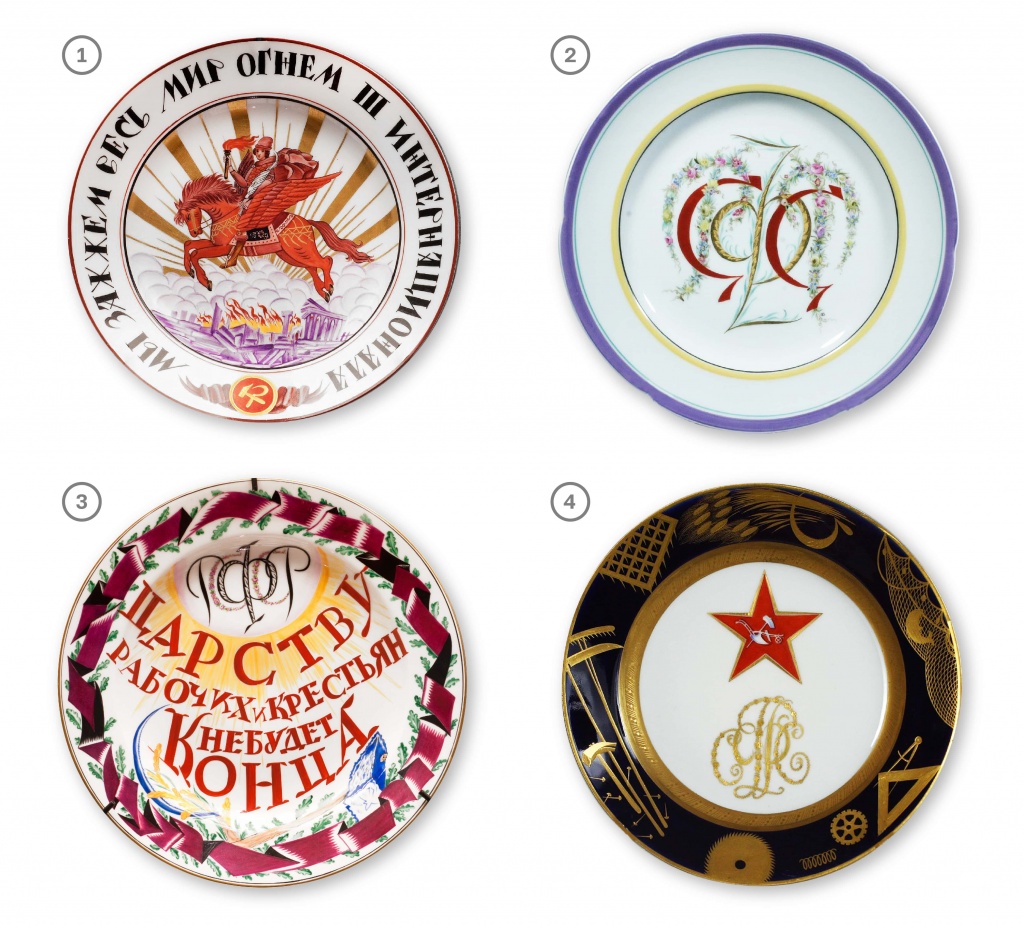
1. Plate "We Will Light up the World with the Fire of the Third International". A.R. Golenkin. Petrograd. Petrograd, 1922. Porcelain, overglaze painting, gilding, diverging pattern. 2. Plate with the monogram "RSFSR". S.V. Chekhonin (engraving artist), G.M. Sudarchikov (artist painting). Petrograd. Petrograd. 1921. Porcelain, overglaze painting, gilding, diverging pattern. 3. Plate "The Kingdom of the Workers and Peasants Will Never End". S.V. Chekhonin (engraved). Petrograd. 1922. Porcelain, overglaze painting. 4. Plate with the inscription "RSFSR". M.M. Adamovich (author of the drawing). Petrograd. Petrograd. 1921. Porcelain, underglaze glazing, overglaze painting, gilding, diverging pattern
The arrival in the museum of the famous collection of Soviet porcelain that belonged to the family of the famous variety artist Leonid Osipovich Utesov was therefore a great stroke of luck. The first connoisseur of the collection was Svetlana Vyacheslavovna Kavetskaya, head of the Ceramics and Porcelain Department and a well-known museum expert. She still remembers well when she crossed The Garden Ring, just opposite the museum, and approached the large building in Karetny Ryad, worrying. The famous house, built in the late 1950s and early 1960s for Bolshoi Theatre actors, ballet, classical music and pop stars. A house that for many years became one of the epicentres of the cultural life of the capital.
Here Utesov lived from 1970 to 1982 in a tiny (by today's standards) three-room flat. Today the building's facade is commemorated by a plaque. Leonid Utesov was a multi-faceted personality who became a cult figure in the history of Soviet art. Having no special education he became the first people's artist on the stage, played the violin and the guitar, headed an orchestra, wrote lyrics for songs. He made five films, wrote three books, was a friend of famous composer Isaac Dunayevsky, writers Mikhail Zoshchenko and Isaac Babel. Many television programmes were made about him. Throughout his long life, Utesov gave people joy with his art, cordiality and good humour. Utesov's fate is largely a reflection of the era in which he lived, the more interesting and significant for us is the collection of "proletarian porcelain" kept in the artist's family.
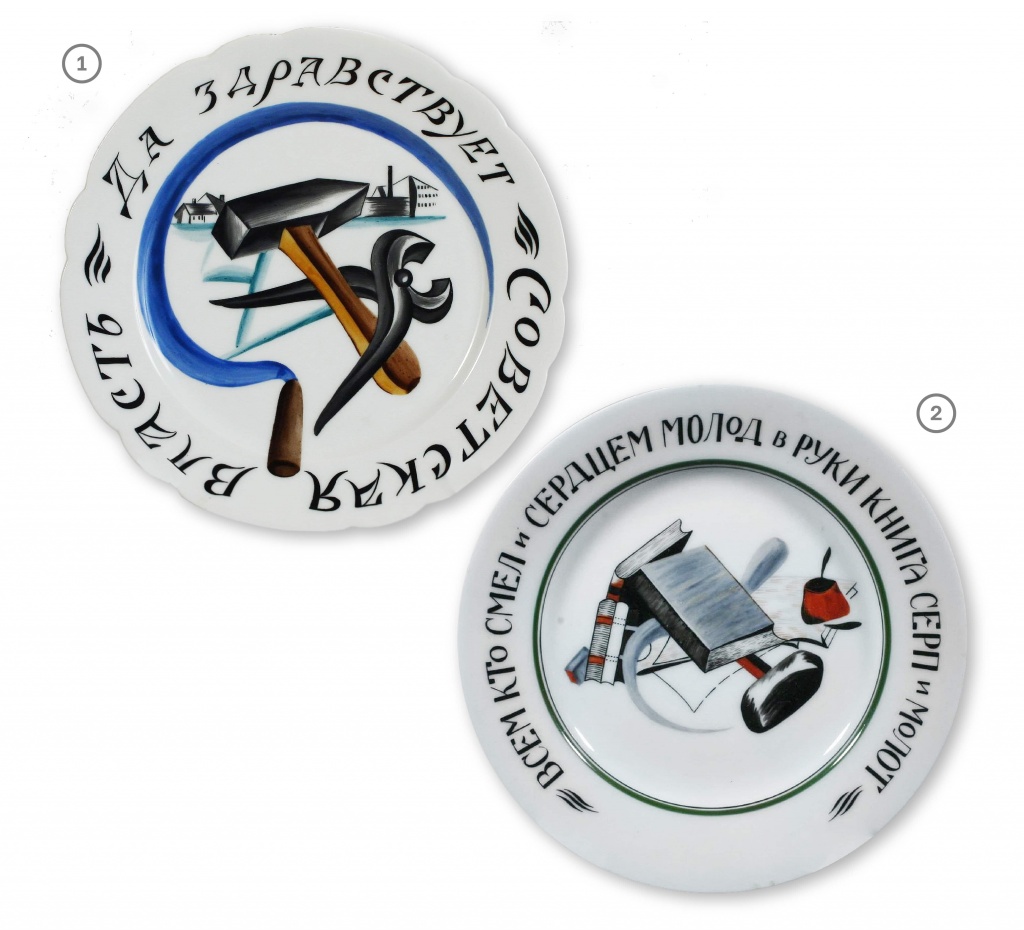
1. Plate "Long live Soviet power". E.B. Rosendorf (author of the drawing). Petrograd. 1921. Porcelain, overglaze painting. 2. Plate "To all who are brave and young at heart, in the hands of the book, hammer and sickle. R.F. Wilde (author of the figure). Petrograd. 1921. Porcelain, overglaze painting.
Until late in the evening, Svetlana Vyacheslavovna could not turn her eyes away from the splendor of the painted plates and dishes - she looked at them, compared them, analyzed them and made lists. Her collection included works from the early years of 1918-1919 as well as more recent works created during the first decade of October (about 30 items in all). Works by practically all the famous artists who worked at the State Porcelain Factory in Petrograd were displayed.
Serial and unique plates, decorative dishes by S. Chekhonin, A. Schekotikhina-Potottskaya, M. Adamovich, R. Wilde, Z. Kobyletskaya and others. The diversity of creative personalities, different approaches to solving a common task - the creation of a new style in porcelain.
Thus an interesting phenomenon in the history of Soviet and European art began to form - "AGIT-FARFOR" (propaganda porcelain). And how important it was that these examples of high art ended up in the collection of the only specialised museum dedicated to the history of decorative art, its development and the emergence of the art industry in Russia.
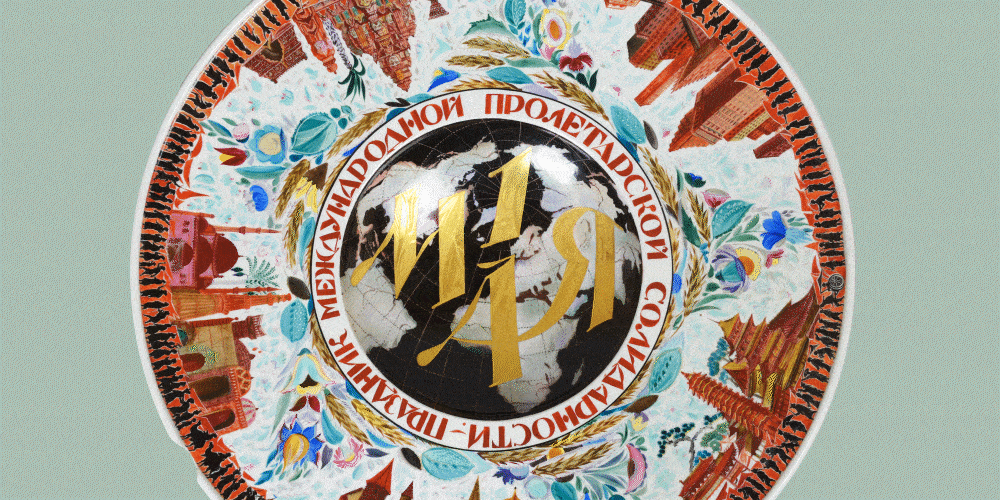
Decorative plate "May 1 - Celebration of International Proletarian Solidarity". Z.V. Kobyletskaya (author of the painting). Leningrad. Leningrad. 1928. Porcelain, overglaze painting, gilding, diverging pattern
In March 1918, the State Porcelain Factory (former Imperial Porcelain Factory) became one of the centres of the new art of propaganda. The oldest factory was given a role of an artistic laboratory and the porcelain spoke a previously inaccessible language. The political slogan, the emblematic of the new state, ornamental painting in a bright artistic form had a direct and active effect on the viewer, unceremoniously bursting into the comfort of St. Petersburg flats. The refined material suddenly started speaking in the straightforward language of the poster, the lubok.
This phenomenon, new to the world of decorative art, was startling in its recklessness and the categorical nature of its texts, which at times resembled the verdict of a revolutionary tribunal. And all this was combined with a professional culture of drawing, the uniqueness of the idea and embodiment. Emotional lift gave rise to the scope: monumentality of images and artistic tasks were unexpectedly manifested in the traditional chamber art of everyday objects.
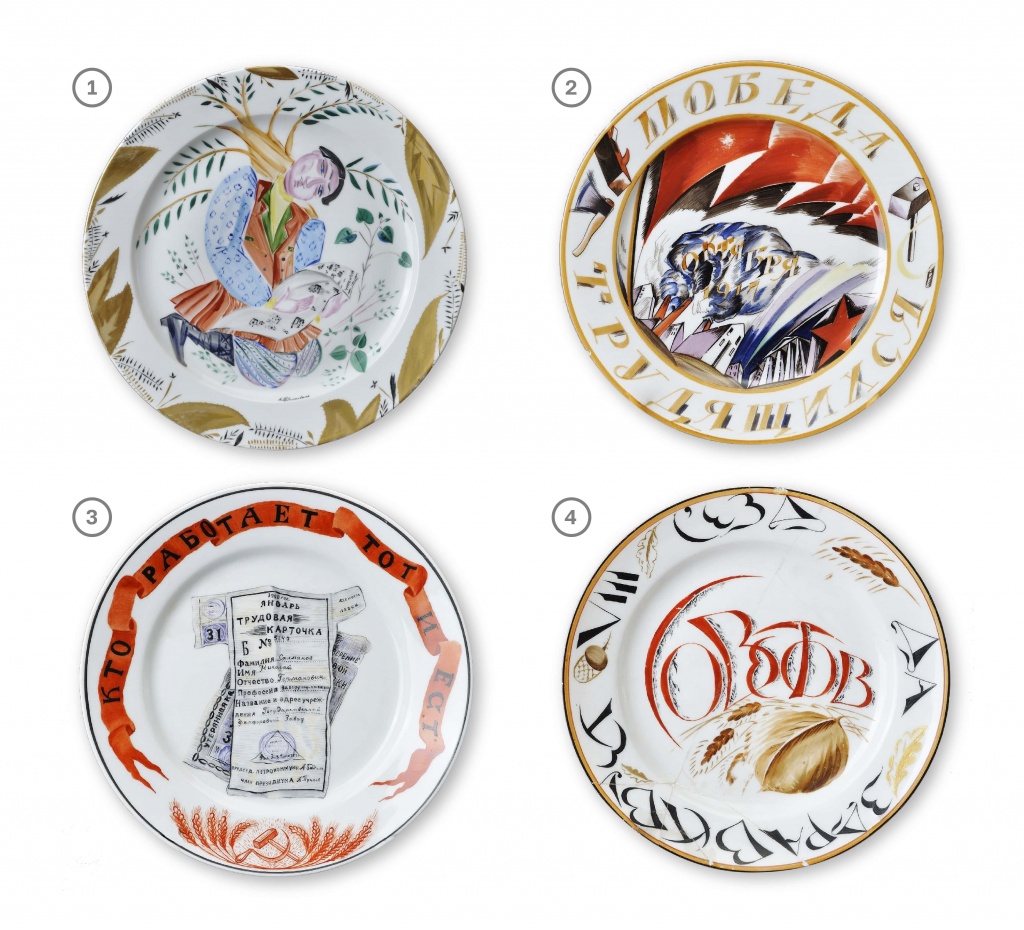
1. The "Singing International" dish. Author of the painting: Alexandra Vasilyevna Schekatikhina-Pototskaya. Petrograd. Petrograd. 1921. Porcelain, overglaze painting, gilding, carving. 2. Plate "Workers' Victory". Executor of painting: Alisa Rudolfovna Golenkina, author of drawing: Veniamin Pavlovich Belkin. Petrograd. Petrograd. 1919. Porcelain, overglaze painting. 3. Plate "Worker's Card". Author of the drawing: Vasily Porfiryevich Timorev. Petrograd. Petrograd. 1920. Porcelain, overglaze painting. 4. Plate "The 8th Congress of Soviets". The artist of the painting: Varvara Rukavishnikova, the author of the drawing: Zinaida Viktorovna Kobyletskaya. Petrograd. 1920. Porcelain, overglaze painting, gilding.
Sergei Chekhonin, the artistic director of the GFZ, was the first to introduce the emblem of the workers' and peasants' state-the hammer and sickle-into propaganda porcelain (AGIT-FARFOR). A brilliant draughtsman and calligrapher, master of ornamentation and book miniatures, he developed a new style by transferring the symbols of the young state to the surface of porcelain. He started with simple propaganda plates painted in colours only, such as the plate with the blue sickle and hammer with flowers and leaves scattered all over the plate which had been popular since 1918. The artist's long-standing fondness for ornamental motifs and the influence of Russian folk art - the Rostov finishers - were evident.
In 1919, Chekhonin created works, full of romantic rush into the future. Among these is the dynamic, vivid plate The Red Ribbon (1919), which is expressive thanks to its saturated red-orange colour. The Imperial factory's porcelain has not displayed this strength of colour since the early 20th century, with preference being given to painting in muted tones. After the revolution, artists once again made extensive use of colour as one of their main expressive means. There was even a specially composed paint "Red Coral", which was used by Chekhonin.
A more complex composition is in a very interesting work by Mikhail Adamovich, which became most popular - a plate with the slogan "He who does not work does not eat" (1922). The multicoloured lettering covers the entire surface of the plate, with a professional, very vivid portrait of Vladimir Lenin at its centre. This is a sketch by Adamovich based on a drawing by Nathan Altman. The victory of the new state is expressed symbolically - the red star is trampling on the Tsarist eagle. Despite the signs of a harsh time (food cards), the bright abbreviation RSFSR brings a sense of confidence and optimism.
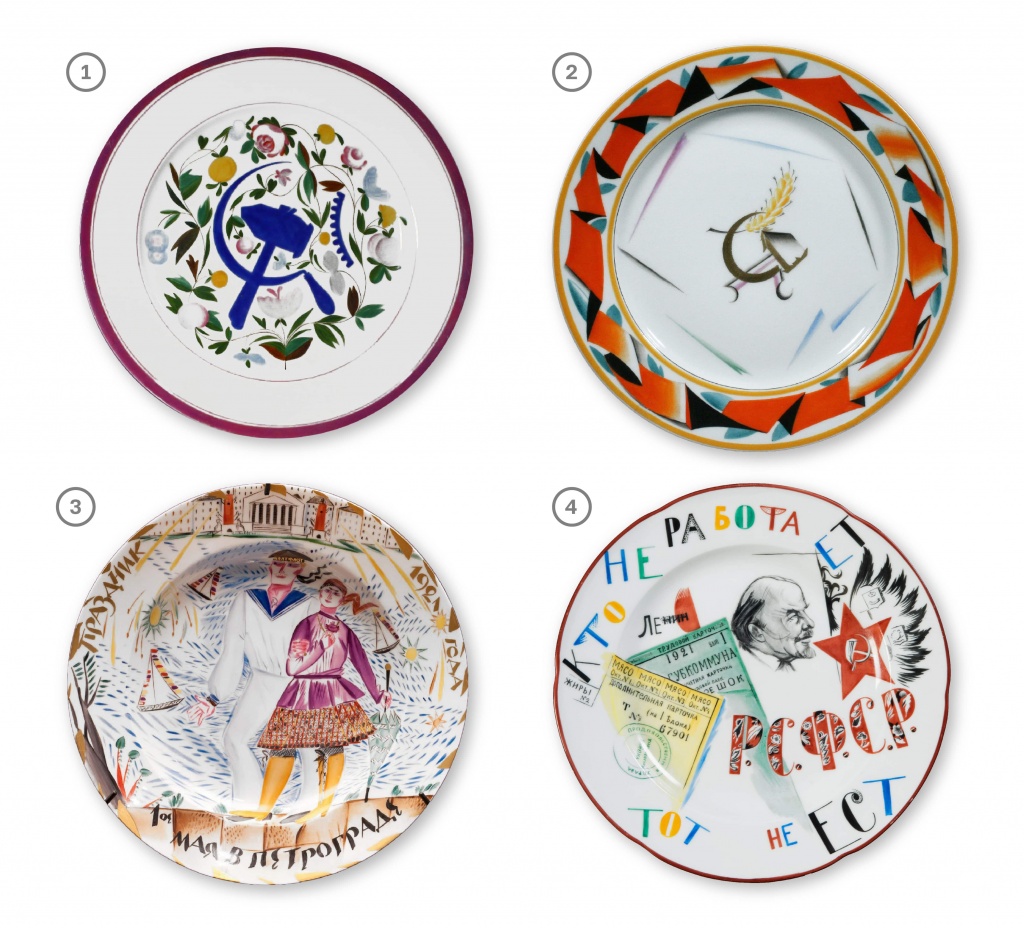
1. Plate 'Blue Coat of Arms'. S.V. Chekhonin (author of the drawing). Petrograd. 1918. Porcelain, overglaze painting. 2. The Red Ribbon Plate. S.V. Chekhonin (author of the drawing). RSFSR, Petrograd. 1919. Porcelain, overglaze painting, gilding, diverging pattern. 3. Decorative plate "Sailor's Walk on May 1 in Petrograd. Shchekatikhina-Pototskaya. Petrograd. Petrograd. 1921. Porcelain, overglaze painting, gilding. 4. Plate "He who does not work does not eat. N.I. Altman, M.M. Adamovich (pictured). Petrograd. Petrograd. 1922. Porcelain, overglaze painting.
The main jewels in the crown of Utesov's collection are undoubtedly the works of the remarkable artist Alexandra Schekatikhina-Potototskaya, the brightest young talent of the GFZ. In her decorative dish "Sailor's walk on May 1 in Petrograd" (1921) – we can see life of post-revolutionary Petrograd: sailor, walking with a girl on the Neva embankment. Shchekatikhina-Potototskaya has her own painting style and covers the entire piece with a drawing. On the glossy surface of the porcelain she paints like on a canvas. The painting subjugated the form, flowing onto the sides of the dishes and plates. The drawing ceased to be decorative and took on an artistic significance. Thus brittle bright porcelain masterpieces were born.
The demand for the works of the State factory was very high, both on the domestic and foreign antique markets. Due to their artistic merits, and the "author's" nature (most of the works were signed and dated), they immediately became "collectible" porcelain, the "ambassador" of Soviet art abroad.
"These beautiful products have become coveted items for any collector in Russia and abroad", - wrote the Soviet statesman, the People's Commissar of education AV Lunacharski.
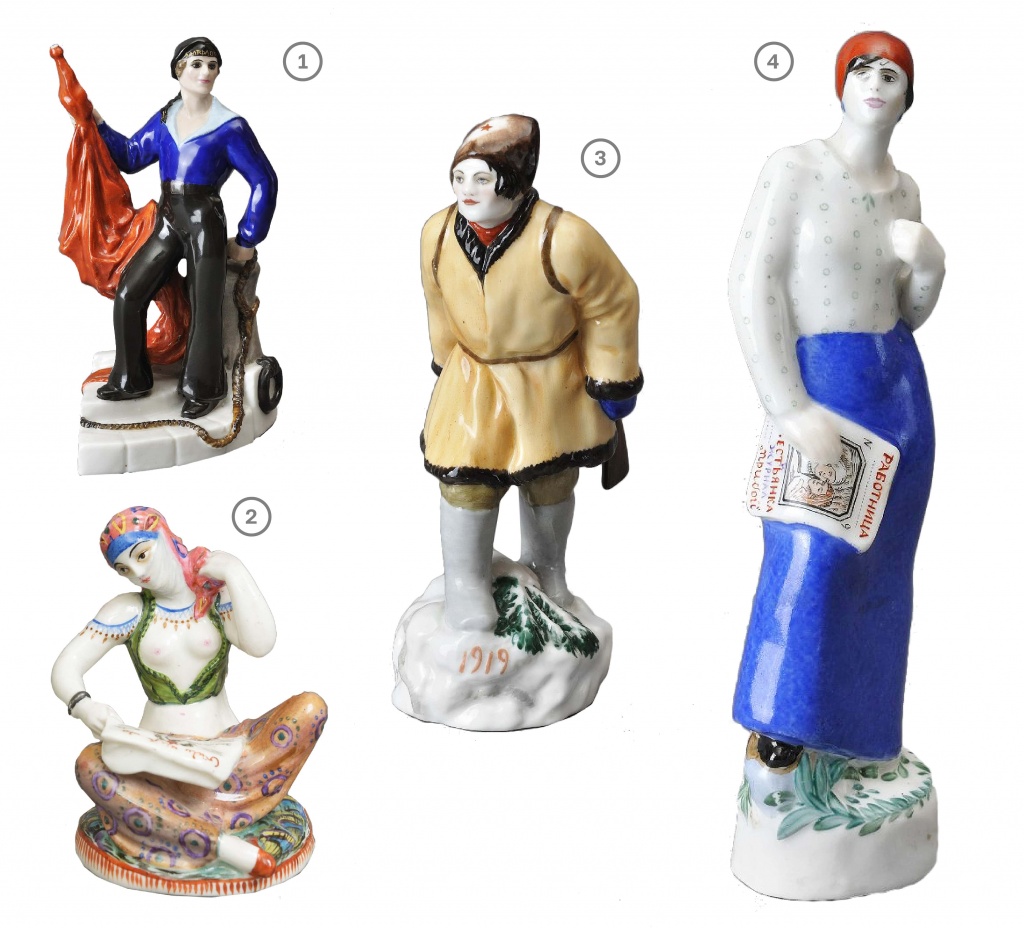
1. Sculptural composition "Sailor with Banner. Nikolai Danko (author of model). Petrograd. 1920s (model of 1921). Porcelain, overglaze painting, gilding. 2. The sculpture "The Awakening Orient" ("The Turk Woman"). E.Ya. Danko (author of the model). Petrograd. Model of 1921, cast in 1920s. Porcelain, overglaze painting, silvering. 3. Sculpture "Partisan in the Campaign. N.Ya. Danko (author of the model). Petrograd. Model of 1919, made in 1923. Porcelain, overglaze painting. 4. The Worker, Speaking." Sculpture. N.Ya. Danko (author of the model). Leningrad. Model of 1923. Made in the 1920s. Porcelain, lathing, overglaze painting
To this day the virtues of propaganda porcelain are indisputable and universally acknowledged. It is displayed at the most prestigious exhibitions, enjoys the unfailing attention of the antique market and is exhibited in museums.
But this was not always the case. Porcelain of the first post-revolutionary years knew sad times of almost complete obscurity and rejection. It is surprising that it was in this dull period, in the late 1930s and early 1940s, that a new generation of collectors was formed. They lost much of the former collectors’ scale, but were often driven by the desire to preserve cultural values for posterity. That was also the time when the collection of propaganda porcelain of the well-known entertainers Alexander Menaker and Maria Vladimirovna Mironova was launched. In 1939 they performed together for the first time with musical comedy sketches and in 30 years of working together their comedy duo became classics of the Soviet stage.

1. The sculpture "Red Guardsman". V.V. Kuznetsov (author of the model). Petrograd. Model of 1918. Made in 1922. Porcelain, overglaze painting. 2. The Sentinel Sculpture. T.O. Davtyan (author of the model). Leningrad. The First Half of the 1930s. Porcelain, overglaze painting
In those years, the fashionable and prestigious items meant special respect for the “indisputable” - empire furniture and old porcelain. A collection of Soviet porcelain from the recent past seemed an impractical oddity. Maria Vladimirovna said: 'This fascination was a constant object of jokes among our friends. Real collectors collect antiques and you collect... crocks".
Undoubtedly, one must have had good taste and a flair of a true collector to "see" these things, feel their artistic charm and gather such a complete collection in the few years before the war. In his memoirs Alexander Semyonovich remembers: "While still living in Leningrad I began to develop a passion for collecting Soviet porcelain from the Lomonosov factory. Having caught my virus, Maria Vladimirovna became an even more passionate collector. Together with her, we managed to collect many works that are now unique. Later on, when they often visited Leningrad, they invariably stopped by the shop on Nevsky Prospect. It was here, in a tiny commission store, that most of their happily and quickly built-up collection was acquired.
At the very end of the 1980s, the personal "memorial" part of the collection remained in the house of Maria Vladimirovna in a quiet side-street on Arbat. And the main part - the Soviet porcelain of the 1920s - was housed in an old mansion on Delegatskaya Street and handed over by the Ministry of Culture of the USSR to our museum (over 200 items).
Two superb private collections - those of Utesov and of Menaker and Mironova - formed the basis of the widely known collection of propaganda and decorative-art porcelain of the 1920s and 1930s in the All-Russian Decorative Art Museum.



